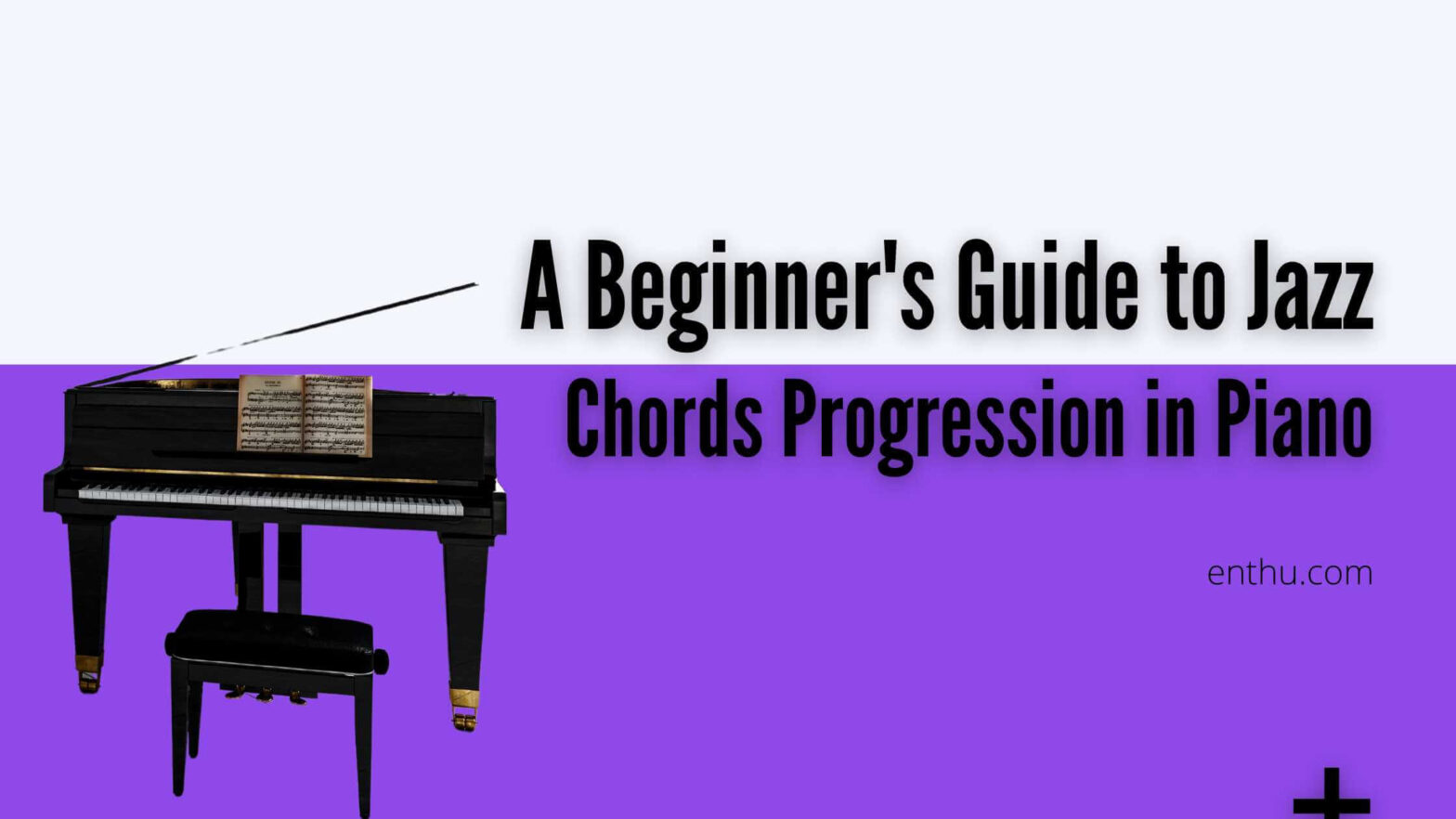Jazz Piano uses the same 12 notes as any other musical genre. But do you know what makes it different? It has its aura, style, and charm. And it is only because of the unique chord progressions which jazz has!
So no doubt jazz pianists like Duke Ellington and Bill Evans carried their style, but some beginner pianists even find it daunting to get started with jazz.
The harmonic complexity of the piece necessitates a high playing degree of technical skill. When you feel overwhelmed by jazz chords and scales or even lead sheet music, we find that breaking it down into smaller chunks helps.
Today we will analyze several common jazz chord progressions in keyboard, examples, and popular songs. As a guide, you should use these in your playing, improvisation, and composition during practice.
Beginner Jazz Chord Progressions in Piano
1. Major ii – V – I
You would think you’ve entered “jazz chord odyssey” territory after knowing this particular piano chord. No doubt, as it is the most common progressions to start with. Playing the II-V-I progression is an excellent way for jazz artists of all ability levels to hone their musical and harmonic abilities in creative ways.
Major ii – V – I jazz theory
Each chord in the progression has a root on the second degree (supertonic), the fifth degree (dominant 7th chord), and the tonic. Thus, establishing and playing the tonality vi-ii-V-I progression of root movement by descending fifths includes an ii-V-I progression.
Examples of Major ii – V – I
| Jazz Standard Form | II | V | I |
| On C Scale | Dm7 | G7 | CMaj7 |
| On D scale | Em7 | B7 | Dmaj7 |
Songs based on Major ii – V – I
To give your fingers the taste of this progression, I recommend trying out Moose the Mooche by Pat Metheny, Isn’t It Romantic by Tal Farlow.
2. Minor ii—V—I
If you are a Latin jazz guitarist lover, you will often hear this minor harmony. In contrast to the major ii-V-I, it has a somber atmosphere. It makes one think of an upscale bar where one may relax with friends and enjoy a well-made beverage.
Minor ii—V—I jazz theory
In its most basic form, the dominant is a major triad, while in more advanced forms, it is often a dominant seventh chord. The half-diminished seventh chord, derived from a minor seventh chord based on the supertonic, is a powerful, dominant chord.
Examples of Minor ii—V—I
| Jazz Standard Form | II | V | I |
| On C Key | Dm7 | G7 | Cm7 |
| On D key | Em7 | B7 | Dm7 |
Songs based on Major ii – V – I
Autumn Leaves by Eric Clapton and Sweet Georgia Brown by Ben Bernie are some of the very popular jazz pieces that the world knows. Certainly, you must try it!
3. I IV Jazz chord progression
Blues pianists will recognize the sound of an I chord, changing to an IV chord as a standard element of the jazz piano world. With only this one-chord sequence, you’ll be able to enter the realm of jazz music, where virtuoso technique and advanced music theory meet.
4. IV (Maj)-iv(min)
The IV (major) to iv (minor) harmonic progression is an essential tool for any beginner jazz pianist since innumerable jazz writers and improvisers have used it, as also as many pop performers like the Beatles.
IV (Maj)-iv(min) Theory
It’s usual practice to alter a major-key IV chord to a minor-key iv while working in that Key (minor). Since it is not in the tonic key but uses the tonic note as its root, this 4-minor chord is referred to as a “borrowed chord.”
The iv chord’s third note, the flat sixth, is the Key’s tonic. As a result of its widespread usage for sentimentality in musical theater, b6 has been dubbed the “nostalgia note” by composer Adam Neely.
Example of IV iv
| Standard Progression | IM7 | I7 | IVM7 | ivm7 |
| On C scale | Cmaj7 | C7 | Fmaj7 | Fm7 |
| On D scale | Dmaj7 | D7 | Gmaj7 | Gm7 |
Songs based on IV iv
To try out this melancholic progression, hear our songs like Satin Doll and Cherokee by Tal Farlow and Joy Spring by Joe Pass.
5. I – vi – ii – V
Do you know how this progression sounds? Sounds light and airy, like a walk down the beach on a nice, sunny day.
It might have a happy, upbeat vibe, but it can also have a sadder tone, depending on the speed and the other chords played around it.
I – vi – ii – V jazz Theory
Diatonic Theory states that the vi chord must be minor. However, transforming it into a dominant 7 is standard practice in jazz music. You’ll likely understand why if you give the chord qualities a try. It sounds natural though not entirely expected. However, the dominating 7 will provide far more taste and color to the dish than the m7.
Example of I – vi – ii – V
| Standard Note | I | VI | II | V |
| On the key of C | Cmaj7 | A7 or Am7 | Dm7 | G7 |
| On teh key of D | Dmaj7 | B7 or Bm7 | Em7 | B7 |
Songs based on I – vi – ii – V
To get familiar with this striking novelty, we recommend you hear the classic Cheek to Cheek by Fred Astaire.
6. Rhythm Changes
Do you know that this particular jazz progression is named after a song? I’ve Got Rhythm, a song by Gershwin in 1930, gave birth to this progression.
Rhythm Changes’ inherent ease of usage makes them suitable for various musical contexts. They provide plenty of room for wiggle room in terms of swapping out components and adjusting proportions.
Rhythm Changes Theory
The Rhythm Changes are composed of two chord qualities AABA form consisting of an A portion and a B section.
The first segment, A of Rhythm Changes, is a turnaround with a secondary dominant. The B part of Rhythm Changes is an expanded version of the 3-6-2-5-1 progression (with secondary dominants).
Example of Rythm Changes
| Standard Form | III7 | VI7 | II7 | V7 |
| On C scale | D7 | G7 | C7 | F7 |
| On D scale | E7 | B7 | D7 | G7 |
Songs based on Rythm Changes
This chord sequence is based on the I-vi-ii-V progression, with a little modification between the first and second two-bar phrases. Some songs based on these jazz progressions are Duke Ellington’s “Cotton Tail” as well as Charlie Christian’s “Seven Come Eleven”.
7. ii-vi-ii-v (The bridge progression)
It’s worth emphasizing that the iii-vi-ii-v is often utilized as a turnaround between parts in jazz melodies. Songs influenced by jazz music tend to be rather dynamic, with many changes in the chord progression rather than relying on the same few chords throughout.
Tips while using iii-vi-ii-v
If you’re working with an ii major V chord as the foundation of your music, you may also use the minor ii-v. With the common use of both major and minor scales in jazz melodies, any chord may be approached experimentally in the same manner as the ii-v chord substitution.
A few Tips before starting Jazz Chord Progressions
- Each jazz chord progression only has a root and a seventh on the left hand. In its most fundamental form, it’s called the chord voicings. You should also know how each note functions within its voicing.
- The major ii-V-I chord sequence is the most often used chord progression in jazz standards and hence deserves a lot of practice.
- The 3rds, and 7ths of each chord are important so that you may employ them in your improvisation. Learning to improvise over chord changes is a crucial aspect of jazz, and jam sessions are vital to developing a jazz sensibility.
FAQs
What chords are used in the Jazz piano style?
7th Major, Minor, Dominant, and Diminished Chords are used in jazz piano style.
Is Playing Jazz Piano Simple?
The art of jazz piano cannot be learned without dedication and perseverance. However, EnthuZiastic’s courses can help you simplify this journey of learning jazz music on the piano.
When playing jazz, what mode works best?
The Dorian mode is the most typical choice when playing jazz over minor chords. Dorian is a useful tool for composing solos, chords, and even progressions.
What is the most overused jazz chord progression?
I-V-vi-IV is universally recognized as the gold standard. From post-punk to country music, it has been employed in almost every style.
Are 7th chords the only chord used in jazz?
Apart from the seventh, jazz often makes use of ninth chords. The diminished seventh chord is the only seventh chord type that does not have a ninth added to it when used in classical or popular music while the other categories have the ninth.
Learn Piano From Expert Teachers
Conclusion
Jazz Songs are a handful of standard chord progressions that keep popping up in different forms throughout the piece. Knowing the standard jazz chord progressions is the Key. While the chord mentioned above progressions are the stepping stone, you must work towards improvisation to create amazing jazz music solos.
However, you are in the best place! Taking piano lessons online is a terrific and simple approach to improving your jazz piano playing. At EnthuZiastic, we have curated piano courses that explain and apply these ideas to jazz music improvisation. Visit to know more!

